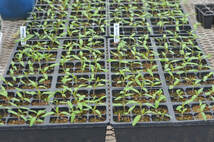Starting Garden Transplants from Seed

Following are the steps needed to be successful in seed starting.
Purchase Recommended, Quality Seed: Start by taking a look at our recommended varieties at
http://www.bookstore.ksre.ksu.edu/pubs/L41.pdf . These plants have proven themselves across the state of Kansas and this is a good place to start when deciding what to plant. However, also talk to your neighbors, friends and your local garden center about what has worked well for them. Obtain your seeds from a reputable source including garden centers and seed catalogs. If choosing seeds from a business that does not specialize in plants, pay special attention to the package date to make sure the seed was packaged for the current year. Though most seed remains viable for about 3 years, germination decreases as seed ages. See the accompanying article on using old garden seed for more detailed information.
Determine the Date to Seed: There are two pieces of information that needs to be known in order to determine the date to seed transplants: the target date for transplanting outside and the number of weeks needed to grow the transplant. There is a companion article in this newsletter listing common plants and the number of weeks needed to grow a transplant.
The target date for transplanting the cool-season crops such as broccoli, cabbage, cauliflower and onions are the end of March to the beginning of April. Warm-season crops like tomatoes, peppers and most annual flowers are usually planted about May 10 in Manhattan. Northern Kansas may be a week or so later than Manhattan and southern Kansas a week or so earlier.
Sowing Seed: Do not use garden soil to germinate seed as it is too heavy and may contain disease organisms. Use a media made especially for seed germination.
Keep Seed Moist: Seed must be kept moist in order to germinate. Water often enough that the media never dries. Using a clear plastic wrap over the top of the container can reduce the amount of watering needed. Remove the wrap after the seedlings emerge.
Light: Most plants will germinate in either darkness or light but some require darkness (Centurea, Larkspur, Pansy, Portulaca, Phlox and Verbena) and others require light (Ageratum, Browallia, Begonia, Coleus, Geranium, Impatiens, Lettuce, Nicotiana, Petunia and Snapdragon).
All plants require adequate amounts of light once emergence occurs. South facing windows may not provide adequate amounts and so fluorescent or LED fixtures are often used. Suspend fluorescent lights 2 to 4 inches above the top of the plants. LED lights are much more variable. Use LED lights that are designed to grow plants and follow the manufacturers recommendations. Regardless of the type of light used, leave the lights on for 16 hours each day.
Temperature: The temperature best for germination is often higher than what we may find in our homes especially since evaporating moisture can cool the germination media. Moving the container closer to the ceiling (top of a refrigerator) can help but a heating mat is best for consistent germination. A companion article lists common plants and their optimum germination temperature. After plants have germinated, they can be grown at a cooler temperature (65 to 70 degrees during the day and 55 to 60 degrees at night). This will help prevent tall, spindly transplants.
Plant Movement: Plants react to movement. Brushing over the plants with your hand stimulates them to become stockier and less leggy. Try 20 brushing strokes per day. However, brushing will not compensate for lack of light or over-crowding. Plants grown under inadequate light will be spindly regardless of any other treatment.
Hardening Transplants: Plants grown inside will often undergo transplant shock if not hardened off. Plants are hardened off by moving them outside and exposing them to sun and wind before transplanting occurs. Start about two weeks before transplanting and gradually expose the plants to outside conditions. Increase the number of hours and degree of exposure over the two-week period.



Leave a Reply
You must be logged in to post a comment.